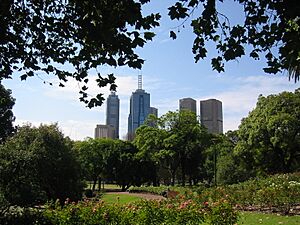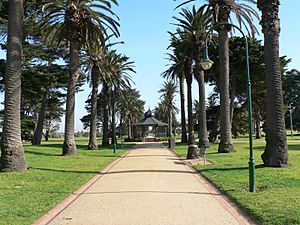Parks and gardens of Melbourne facts for kids
Melbourne is often called Australia's garden city. The state of Victoria is even known as the Garden State! This is because Melbourne has so many amazing parks and gardens, especially near the city center. You can find all sorts of common and rare plants here, with beautiful paths and tree-lined streets. The phrase Victoria – Garden State was even on Victorian car number plates for many years! Lots of towns outside Melbourne also have lovely botanic gardens and parks.
A long time ago, Charles La Trobe, who was in charge of the Port Phillip area, set aside huge areas of land around the city for open spaces, parks, and gardens. Over time, some of this land was used for things like sports stadiums, railways, hospitals, and homes. But a lot of it stayed as parks! This allowed landscape designers like Clement Hodgkinson and William Guilfoyle (who was the Director of the Royal Botanic Gardens, Melbourne) to create many of the beautiful parks and gardens we see today. Many of these green spaces are easy to walk to from the city center.
Contents
Amazing Parks in the City
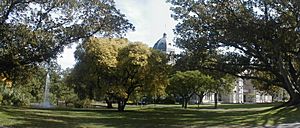
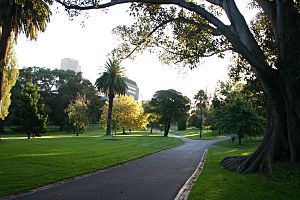
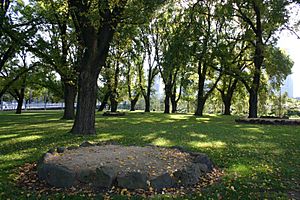
One of Melbourne's oldest parks is Flagstaff Gardens. It's a popular spot for office workers to relax during lunch. The park has a special memorial for the first Europeans who died in the colony. They were buried there between 1835 and 1840.
The Royal Botanic Gardens are truly special. They are located just across the Yarra River from the city center. These gardens were once a swamp! Now, they are home to a wonderful collection of plants from all over the world. The gardens were started in 1846. William Guilfoyle later redesigned them, giving them their beautiful look today. You'll find lovely lakes, monuments, and statues here. When Queen Elizabeth II visited, she gave the gardens the special title 'Royal'. As you walk around, you can also see Government House.
Right next to the Botanic Gardens is Kings Domain. This area has open lawns and many native and foreign trees. It surrounds Government House, the Shrine of Remembrance (a memorial), and the Sidney Myer Music Bowl (an outdoor music venue). The Queen Victoria Gardens and Alexandra Gardens continue the parkland along St Kilda Road down to the Yarra River.
The Carlton Gardens are north of the city center. They are so important that they are listed as a World Heritage Site! The gardens have many different kinds of trees from Europe and Australia. You can see English oaks, White Poplars, Plane trees, and Elms. There are also beautiful flower beds. Every April, the Melbourne International Flower and Garden Show is held here. The Melbourne Museum and Imax theatre are also nearby. There's even a children's playground in the northern part of the gardens!
Royal Park is a huge park, about four kilometers north of the city. It has sports fields, the State Netball Hockey Centre, and the Royal Melbourne Zoological Gardens. The exclusive suburb of Parkville was created from part of this parkland. Important places like the Royal Melbourne Hospital and the Royal Children's Hospital are also located here.
East of the city center are the Treasury Gardens and the Fitzroy Gardens. The Treasury Gardens are a short walk from Victoria's Parliament House. They are a popular spot for public gatherings and festivals.
Across the street from Treasury Gardens are the Fitzroy Gardens. These are one of Australia's most important Victorian era gardens. Inside, you can find Captain Cook's Cottage, a pretty ornamental lake, a cafe, a Model Tudor village, and the famous fairy tree. There's also a tree with scars from the original Wurundjeri people who lived here.
Further east is Yarra Park, where the famous Melbourne Cricket Ground (MCG) is located. This area was once used for police horses. Now, it has several sports ovals, including the MCG. The park features sculptures of Australian sports heroes. You can also see old eucalyptus trees with scars from when the original inhabitants used their bark for canoes.
The Birrurung Marr park was opened in 2002. It's a new riverside park designed to have great views of landmarks like the spire at the Victorian Arts Centre and the towers of St Paul's Cathedral. It also includes the original Speakers Corner, where people used to give speeches and hold protests.
In the suburb of Albert Park, St Vincent Gardens is a very important park. It shows how residential areas were planned around large landscaped squares in the 1800s. The Australian Grand Prix car race is held around Albert Park Lake. This park also has a public golf course and many sports fields. The decision to hold the race here caused some discussions, with groups wanting to protect the public park.
Other notable parks in the inner suburbs include Edinburgh Gardens in North Fitzroy, Fawkner Park, Como Park, and Victoria Gardens in South Yarra. Also, Alma Park and the St Kilda Botanical Gardens in St Kilda, Hedgeley Dene Gardens and Central Park in Malvern, Princes Park in Caulfield, Footscray Park in Footscray, and Hays Paddock in Kew East.
Parks Beyond the City Center
While many famous parks are close to the city, Melbourne's outer suburbs also have many large and important parks and rivers. These include:
- Brimbank Park on the Maribyrnong River in the north-west.
- Westerfolds Park and Yarra Bend Park along the Yarra River.
- Wattle Park in Surrey Hills, which has a historical connection to Melbourne's trams.
- Cherry Lake, Truganina Coastal Parklands, and Altona Coastal Park in the bayside suburb of Altona.
- Werribee Park in Werribee. This huge park includes the Werribee Park Mansion, the Victoria State Rose Garden, the Werribee Park National Equestrian Centre, and the Werribee Open Range Zoo.
- Willamstown Botanic Gardens in the bayside suburb of Williamstown.
- Footscray Park in Maribyrnong, across from the Flemington Racecourse.
- Newport Lakes Park, a 33-hectare bushland area created from an old quarry and rubbish tip in Newport.
- Blackburn Lake Sanctuary – one of the few remaining natural bushland areas in suburban Melbourne.
- Royal Botanic Gardens, Cranbourne, which focuses on Australian native plants.
- Other suburban rivers like Merri Creek, Moonee Ponds Creek, Kororoit Creek, Plenty River, Darebin Creek, and Dandenong Creek also have fantastic trails and reserves.
- Currawong Bush Park in Warrandyte, an important area of native bushland.
- Organ Pipes National Park, a protected area with unique rock formations, located 20 km north-west of Melbourne.
- Point Cook Coastal Park, Point Cook Homestead, Cheetham Wetlands, and the RAAF Aircraft Museum in Point Cook.
Gardens in the Dandenong Ranges
The Dandenong Ranges are east of Melbourne and are famous for their beautiful gardens. The soil here is rich, and it rains a lot, which helps plants grow. In autumn, it's popular to drive through the hills and see the bright colors of the deciduous trees as their leaves change. Some public gardens in the Dandenongs include:
- William Ricketts Sanctuary at Mount Dandenong.
- National Rhododendron Gardens at Olinda.
- Alfred Nicholas Gardens.
- George Tindale Garden.
- Mount Dandenong Arboretum.
- Pirianda Garden, Olinda.
- Karwarra Australian Native Botanic Garden (behind Kalorama Memorial Reserve) in Kalorama.
Private Gardens
Many people in Melbourne love to garden at home, and the city is known for its leafy green suburbs. Lots of private gardens open to the public through Australia's Open Garden Scheme, which actually started in Melbourne!


